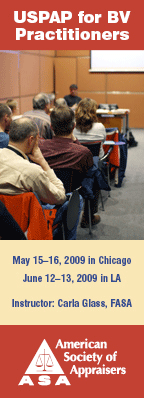
| TAF and the IVF seek comment on their latest exposure drafts Business appraisers have until May 1, 2009 to comment on the Exposure Draft on proposed best practices for The Identification of Contributory Assets and the Calculation of Economic Rents. Developed by The Appraisal Foundation’s (TAF) Working Group on Contributory Asset Charges, topics covered in the exposure draft are: Identification of contributory assets; valuation methodologies and the application of contributory asset charges; and the stratification of discount rates by asset or asset category. The working group will issue a finalized document of suggested best practices after the receipt of comments on the exposure draft. The comment period for The International Valuation Standards Council’s (IVSC) two exposure drafts on the valuation of intangible assets (Revised International Valuation Guidance Note No. 4 Valuation of Intangible Assets and Proposed New International Valuation Guidance Note No. 16 Valuation of Intangible Assets for IFRS Reporting Purposes) is up at the end of April 2009. A closer look at the Butler Pinkerton Model Report A closer look at the new Butler Pinkerton Model Report, an e-book published in collaboration with Morningstar, reveals a number of compelling insights for BV experts. Consider: Pilgrim’s Pride, a poultry slaughtering and processing company, tied for the highest total cost of equity (TCOE = 58.3%), and one of the highest company-specific risk premiums (CSRP = 28.4%), of all of the companies included in the sample database. It is a surprising finding, until one realizes that Pilgrim’s Pride filed for bankruptcy protection on December 1, 2008 after a year of losses caused by high feed costs, low chicken prices, and large debt obligations. Another example: Providence Service Corp, a provider of social services under government contracts, also had a very high TCOE (56.7%) and one of the highest CSRPs (36.0%). Why does this government contract company have such a high cost of capital and such a high CSRP? Answer: Its stock plummeted in 2008 as government budget problems hurt the company's outlook. Moreover, last December, Standard & Poor’s downgraded the company’s credit rating two notches from “B-plus” to “B-minus.” The downgrade was the result of “materially weaker-than expected performance” and concerns with the company’s liquidity position, including its ability to comply with debt covenants. In addition, in the third quarter of 2008, Providence took a material impairment charge to its goodwill ($141 million). Valuation multiples increase for many architecture, engineering, and environmental consulting firms While many architecture, engineering, and environmental consulting firms' values are undoubtedly falling, most valuation multiples increased over the past year, according to ZweigWhite’s 2009 Valuation Survey of Architecture, Engineering, Planning & Environmental Consulting Firms. The survey—based on actual valuations for some 220 firms—reveals that the ratio of reported values of firms in relation to their profit, EBITDA (earnings before interest, taxes, depreciation, and amortization) and net service revenue all increased from the prior year. Value as a multiple of book value is the only ratio that declined. Ian Rusk, an accredited business appraiser and contributing editor to the survey explains that while the survey’s findings may seem surprising, the numbers make perfect sense: “Due to the global recession, revenue and earnings are depressed in many firms, but the capacity to generate future earnings remains. While most firms’ values have fallen due to declining revenue and earnings levels, they have not fallen at the same rate. This is quite different from the trend in valuation multiples of publicly traded firms, which reached stratospheric levels in the fall of 2007, only to decline precipitously along with the rest of the market in 2008 and 2009. Many of the publicly traded firms that had price-to-earnings ratios in the 30x territory in 2007 have seen these ratios retreat back to the 10-15x range. Privately held firms, however, are not subject to the same sorts of market as those in the public realm,” says Rusk. Important guidance for valuations of professional practices This week, on Thursday, April 2, 2009 at 10:00-11:40am PT/1:00-2:40pm ET, BVR kicks off its Industry Spotlight Series kicks off with Valuing Professional Practices, a 100-minute teleconference focusing on the intricacies of professional practice valuation and updated techniques and guidelines that all BV experts need to know. Kevin Yeanoplos, Ron Seigneur, and moderator Stuart Weiss will cover such issues as professional versus personal goodwill, cost of capital, the valuation of intangible assets, the excess earnings method, and more. Two CPE credits are available to attendees. Prospective attendees can register here and listen to Kevin Yeanoplos describe the program. Next up in the Industry Spotlight Series: Valuing Dental Practices on May 14, 2009. Report proposes limiting discovery—and litigation experts A new report, issued by the American College of Trial Lawyers and the Institute for the Advancement of the American Legal System Task Force on Discovery, examines the role of discovery in perceived problems in the civil justice system and makes recommendations for improvement. Among the 29 proposed principles contained in the report: “The number of experts and the process for deposing them often significantly drives up costs; except in extraordinary cases, only one expert witness per party should be permitted for any given issue.” The report also concludes that:
For insights on how the current discovery explosion has led to increasing Daubert challenges, consider Lost Profits Damages: Lessons Learned from Motions to Exclude Financial Experts, featuring Nancy Fannon and attorney Jonathan Dunitz. This is just one of BVR's On Demand Conference Packs (Recordings & Transcripts). Ad Valorem tax property appraisal reports: 12 things to include There is very little professional literature on the topic of valuation analysis relating to ad valorem taxation. For this reason, BV experts with a need can benefit from the Guide to Property Tax Valuation by Robert F. Reilly and Robert P. Schweihs. The book—available from Willamette Management Associates for purchase online—presents practical advice to solve specific ad valorem tax valuation problems. One example: The authors offer insights on the ad valorem tax property appraisal reports and what they should include: 1) a description of the taxable (or tax exempt) property being appraised; 2) description of the subject asset or subject property bundle of legal rights encompassed by the appraisal; 3) property appraisal objective; 4) the purpose of the property appraisal; 5) the statutory, administrative, or other definition of the standard of value sought in the appraisal; 6) an explanation and description of the valuation analyst’s market research and data gathering procedures; 7) a description of the valuation methods and procedures used; 8) value indications derived and concluded from each method used; 9) a final conclusion of value; 10) a certification or representation of the principal analyst; 11) a statement of relevant assumptions; and 12) statement of the analyst’s professional qualifications. IASB and FASB address off balance sheet activity and accounting for financial instruments In a statement issued by the International Accounting Standards Board (IASB) and the Financial Accounting Standards Board (FASB) after last week’s meeting in London, the boards expressed a commitment to a joint approach to “the overall goal of seeking convergence between International Financial Reporting Standards (IFRSs) and US generally accepted accounting principles (GAAP).” The boards also discussed the projects on financial statement presentation, fair value measurement, financial instruments with the characteristics of equity, and the conceptual framework. Log on to IASB’s Website to register and listen to a Webcast of the meeting. |
Copyright © 2009 by Business Valuation Resources, LLC
BVWire™ (ISSN 1933-9364) is published weekly by Business Valuation Resources, LLC
Editorial Staff | Advertise in the BVWire | Copyright Notice
|
|



